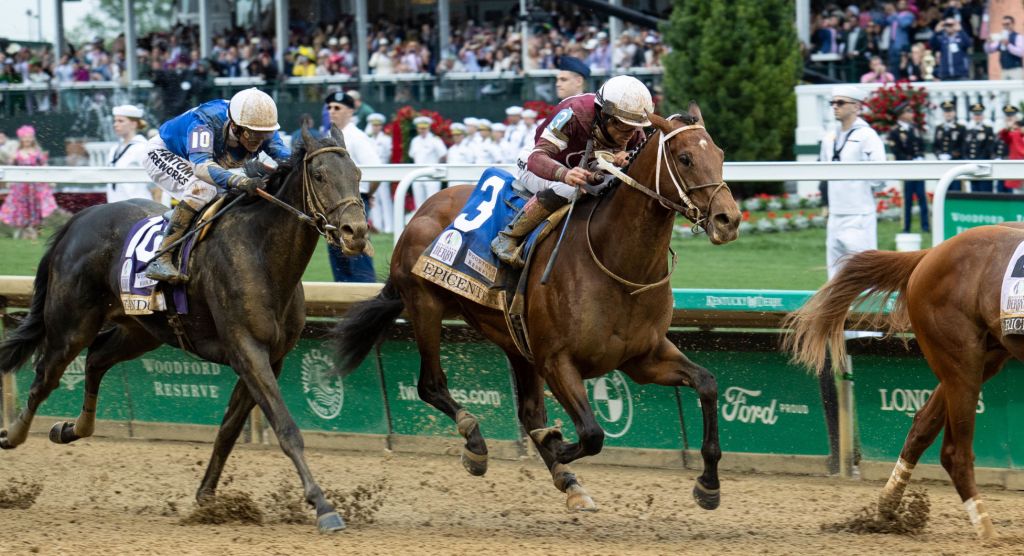Of bourbon, bowties and Epicenters
Published 8:00 am Thursday, April 20, 2023

- Bowling Green-native thoroughbred colt Epicenter (3), with Joel Rosario atop, finishes second in the 148th running of the Kentucky Derby at Churchill Downs in Louisville on May 7, 2022.
Ask anyone.
Louisville and Lexington form the nucleus of the thoroughbred world. But all eyes were on southcentral Kentucky last year when Epicenter, a Bowling Green bred thoroughbred born at Bettersworth Westwind Farms, finished second in the Kentucky Derby. It was the first time in modern history that a local horse made the racing world sit up and take notice.
Or was it?
A stroll through the archives of Riverview at Hobson Grove reveals that Jonathan (John) Hobson raised thoroughbreds there during the 19th century. Turns out, Epicenter wasn’t an anomaly.
Bowling Green has a history of producing fine race horses.
In the 19th century, the nucleus of the thoroughbred breeding world was not in Kentucky.
It was just over the state line, 60 miles south of Bowling Green in Davidson and Sumner County, Tennessee. Farms like Belle Meade, Fairvue (Fairview,) Kennesaw and Rose Mont were the all-stars of the American thoroughbred breeding world. Famous stallions like Jack Malone, Bonnie Scotland, Iroquois and Enquirer stood at Belle Meade in Nashville. Fairview Farms in Gallatin offered St. Blaise, winner of the 1883 English Derby. Kennesaw Farm owned stallions Luke Blackburn and George Kinny, both sons of Bonnie Scotland. Glencoe, the great sire of many renown broodmares, stood in northern Alabama, just across the Tennessee line.
John Hobson exercised his geographic advantage from Riverview to this bounty of southern bloodstock.
An 1881 sale of thoroughbred stock by John Hobson lists 10 notable horses for sale along with their bloodlines. Their pedigrees are generously sprinkled with the names of great 19th century stallions like, Glencoe, Iroquois, Jack Malone and Epsilon. Several of his horses descended directly from one of the greatest thoroughbred stallions of all time, Lexington.
John Hobson knew what he was doing.
One of Hobson’s horses, Blacklock, had an interesting background. During the Civil War, he was owned by a Tennessee man, Baile Peyton, at Station Creek Farm in Sumner County. When an army of marauders passed through, they often helped themselves to supplies and destroyed what they could not carry. This included horses. Baile Peyton discovered marauders were approaching his farm and pushed his dining room furniture against the walls and covered the floor with straw. Next, he led his four prized stallions (which included Blacklock) into his dining room, bolted the door and closed the shutters. The horses were quiet, the marauders were clueless and all four stallions survived the Civil War. Hobson bought Blacklock in 1874.
With Tennessee wearing the crown for thoroughbred breeding in the late 19th century, one would hope that at least the best tracks were in Kentucky, but that was not the case. New York held that title. Saratoga Race Course in Saratoga Springs was the place to race.
There’s a reason why Kentucky horses raced in New York and turned to southern neighbors for their champion bloodlines. After the Civil War, the thoroughbred industry declined in Kentucky.
Violence, loss of stock to the war, lack of labor and unregulated gambling turned the sport of kings into a sport of scoundrels in Kentucky.
Fortunately, Louisvillian Meriwether Lewis Clark Jr. visited England and hatched a plan to help Kentucky regain its preeminence in the thoroughbred world. He organized the first Kentucky Derby on May 17, 1875, opening Churchill Downs. To ensure the sport attracted the “right” crowd, Clark insisted on a dress code of full morning dress to attend the Derby. That meant long dresses and hats for the ladies with cutaway coats, top hats and the neckwear du jour for the gentlemen – the bowtie.
Kentucky had even more to showcase that first Derby than fast horses and fashion. We just happened to produce an excellent whiskey. Legend has it that Henry Clay, the senator from Kentucky, introduced the “Mint Julep” in the Round Robin Bar at the Willard Hotel in Washington, D.C., in 1850 using the finest bourbon from his home state. By 1875, these sweet treats were all the rage and still are today. It is very likely that these bourbon-based cocktails were quenching thirsts at that first Derby. The Mint Julep became the official drink of the Kentucky Derby in 1983.
Kentuckians proudly celebrate their culture during Derby Season and share it with the world.
Louisville and Lexington now form the epicenter of the thoroughbred industry, but history shows that Bowling Green has a seat at the table.
The Friends of Riverview and Atha Ford invite you to celebrate the thoroughbred legacy of Bowling Green along with the Kentucky Derby season on April 21 at The Venue on 939 Adams. The “Bourbon and Bowtie” fundraiser will have something for everyone. There will be a silent auction and Derby related games to entertain you, the finest Kentucky beverages of bourbon, craft beer and wine to quench your thirst, and delicious local food to satisfy your appetite.
Don your finest hat or bowtie and join us! Details and tickets available at Riverview by calling 270-843-5566 or https://www.bgky.org/riverview.



